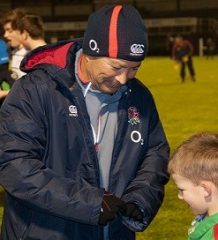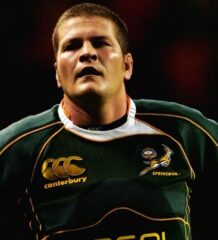Professional Rugby in England taking action on player injuries
The Rugby Football Union (RFU), Premiership Rugby (PRL) and the Rugby Players’ Association (RPA) have today set out the focus areas for their continued action to mitigate the risk of player injuries in the English professional game.
The Professional Game Action Plan on Player Injuries, endorsed by the Professional Game Board (PGB), was launched last March (2018). Data from the 2017/18 Professional Rugby Injury Surveillance Project (PRISP) report, which is published today, will shape the revised action plan priorities for 2018/19.
Reducing injury risk in all sports including rugby union requires a detailed understanding of the factors that underpin injury occurrence, a clear and agreed vision of what level of risk is acceptable and a sustained, co-ordinated and innovative approach from national and international game administrators, coaches, referees, players and medical staff.
The PRISP study is an annual study which has been collated and published since 2002 and provides the professional game in England with the most comprehensive data to assess trends in injury risk. Similar data is starting to be collected in other professional competitions but it will take at least another 12 months before a truly global picture of injury risk can be established.
Since its launch last year, the PRISP Action Plan has involved:
- Meeting with World Rugby to discuss law reviews and instigated a reduced tackle height trial in the Championship Cup.
- Following a review of tackle law application in the Premiership, creating a group to continue to analyse and monitor sanctions given by referees.
- Collaborating with World rugby to explore the feasibility of a post-game high-tackle warning in the 2018-19 season as we explore how we decrease the number of high-tackles that go unsanctioned in the Premiership.
- Holding workshops to discuss training injury risk and concussion risk in the tackle and made a commitment to undertake an annual meeting programme that brings together players, coaches and other club representatives to share the latest evidence in research and injury risk and to discuss practical solutions for key player welfare issues.
- Setting up a new game-event analysis resource to provide important data to further our understanding of how the game develops over time and to add value to a number of ongoing research projects.
- Receiving PGB approval for the introduction of artificial turf pitch maintenance requirements into the minimum standards audit for the 2019-20 season.
The priority areas for the English professional game in the 2018-19 season, based on the latest PRISP results, are:
1. Law design: Collaborate with World Rugby – who have the principal responsibility for the laws of the game – and international unions, competitions and player associations to think innovatively about how the laws of the game can best prioritise player safety outside of the current law review process. This work will focus on working with all stakeholders to review the impact of the Championship Cup tackle height trial, consideration of other law safety initiatives and how to more effectively integrate game event analysis and injury metrics into future law design discussions.
2. Law application: Collaborate with World Rugby to ensure that law application on the height of the tackle is consistent and understood by all stakeholders. Clearer definitions and operational parameters that are understood by all players, coaches, referees, citing officers and spectators are needed for accidental, reckless and deliberate actions which are consistently aligned to the awarding of penalties, yellow and red cards. If there is a desire to change player behaviour to reduce the risk of concussion, we believe that the threshold for receiving a card for a high-tackle is currently too high.
3. Training injury risk: Support clubs and coaches to achieve the optimal balance between performance and injury risk via a series of practical seminars that focus on the planning and management of training and recovery. In addition, we will be;
- Collecting more information on targeted high-risk injuries (matches and training) in order to better understand the risk factors for their occurrence.
- Collecting more information on the details of training activities with a specific focus on timing in the week and the amount and nature of contact included in sessions.
- Exploring the feasibility of improving player management via a more standardised and integrated approach to the collection of player data. In particular a standardised athlete management system and allied GPS system across the Premiership and England.
4. Artificial grass pitches (AGP): Collaborate with World Rugby on their ongoing review of the appropriate performance standard and post-installation testing and maintenance requirements for AGPs in professional rugby union. In addition, we will undertake new research to better understand the grip release characteristics of different types and styles of rugby boots. We believe that understanding the unique interaction between a player’s boot and an AGP will enable us to provide evidence-based guidance to players regarding the most appropriate boots to wear on AGPs and mitigate injury risk.
Nigel Melville, acting RFU Chief Executive said: “The annual PRISP data is critical to helping us understand trends in professional rugby. Mitigating injury risk in a contact sport is a complex area and requires everyone involved in rugby globally to work together if we are to truly address this.
“Since launching our action plan last March, we have seen greater collaboration with World Rugby and have instigated a tackle height trial in the Championship Cup which is currently ongoing. It’s still early days – the action plan was launched towards the end of the 2017/18 season, but we believe the plan covers the key issues and we will use the 2017/18 PRISP injury data to shape the plan as it evolves and is embedded into the English professional game.”
Phil Winstanley, Rugby Director at Premiership Rugby, said: “Player welfare has to and will remain central to Premiership Rugby as an organisation, and working with the RFU and RPA we have undertaken considerable work on the Action Plan agreed last year and agreed further steps which need to be taken this year. There is no “quick fix” solution to addressing some of these issues and work must continue with all stakeholders across the world game. The solution is likely to require input from players, coaches, medics and law makers and the work World Rugby are undertaking in this area is very much welcomed.”
Richard Bryan, Rugby Director at the RPA said: “Given how the game has evolved over the past decade, the Professional Rugby Injury Surveillance Project is now more important than ever. It is essential that as a sport we take heed and act on the findings.
“The introduction of Professional Game Action Plan on Player Injuries last year was welcomed by our Players’ Board. It represented an important step in addressing injury risk in the professional game, but it is essential that we continue to develop the plan and respond to the latest research and data. We are committed to addressing the issues raised in this report and must continue to adapt as a sport to ensure we are protecting the welfare of our players.”
PRISP report
- To download the latest PRISP report click here
PRISP is the most comprehensive and longest-running injury surveillance study in professional rugby union and has monitored the injury risk of Premiership Rugby players in Gallagher Premiership, European and national competition as well as training for the last 15 seasons.
Key findings from the 2017/18 season include:
Overall
- The overall incidence (how often) of match injury in the Premiership was lower than the previous season. It is still slightly higher than the average for the surveillance period. However, it remains within the limits of expected season-to-season variation.
- The average severity of match injuries (the time taken to return to play) for the 2017-18 season was 37 days. This is the second consecutive season that this figure has risen above the expected upper limit of season-to-season variation. This is largely driven by an increase in injuries in the three highest severity groupings (8-28 days, 28-84 days and >84 days absence) and a reduction in the 2-7 day injuries.
- Due to the rise in severity of match injuries, the burden of match injury (a combination of both incidence and severity) increased to the highest seen since 2002 and above the upper limit of expected season-to-season variation.
Concussion
- The most commonly reported match injury was concussion, contributing 20% of all match injuries. Encouragingly, there was a small reduction in concussions compared with 2016-17 – one fewer concussion every eight games.
- The mean severity of medically diagnosed match concussions in 2017-18 was 19 days. This rise in mean severity, first seen last year, is largely due to a relatively small number of concussions (six) where the time to return was more than 84 days compared with previous seasons.
- For the third consecutive year concussion is both the most common and highest burden match injury, followed by hamstring muscle injuries.
- Compliance with the mandatory return to play protocols for concussion was again excellent, with no players returning to play in less than six days.
Tackling
- 52% of all match injuries are associated with the tackle, with 28% of all injuries associated with tackling and 24% associated with being tackled.
- 2017-18 is the first season that the incidence of all injuries was greater for the tackler than the ball carrier.
- Concussion accounted for 18% of all injuries to the ball carrier and 37% of all injuries to the tackler, highlighting the tackle as the key game event to consider when developing concussion and all injury reduction strategies.
Training
- The incidence of training injuries remained stable during the 2017-18 season. However, the average severity rose to its highest recorded level at 37 days and above the expected limits of variation. As a result of the increase in severity of training injury the burden of training injury in 2017-18 again rose substantially and above the upper limit of expected variation. In total, 38% of all injuries were sustained during training.
- There was a significant increase in the incidence of injuries sustained in rugby skills contact training and non-weights conditioning sessions.
- Concussion was the most common injury in full contact training sessions with concussion and hamstring injuries being the most common injuries in semi-contact sessions
AGPs in professional rugby
- There was no significant difference in the incidence, severity or burden of match injuries between artificial turf and grass for the 2017-18 season.
- When the data collected over the past five seasons is combined, the incidence of match injuries on natural grass and artificial turf are not different. However, the severity of match injuries on artificial turf is greater than that on natural grass, with an injury sustained on artificial turf lasting, on average, nine days more than one sustained on natural grass (natural grass, 30 days; artificial turf, 39 days). Consequently, the burden of injuries on artificial turf pitches is higher than those on natural grass.
- When considering injury risk by body location, both severity and burden were greater for lower limb match injuries sustained on artificial turf with this being most marked for hamstring and foot and toe injuries.
- When combining three seasons of training injury data to compare injuries on artificial turf versus natural grass, a similar trend to match injuries is apparent with similar incidence on both turf types while severity and burden and significantly higher on artificial turf.
Simon Kemp, RFU Medical Services Director said: “There is strong evidence that while the likelihood of injury in the professional game appears to be stable, the increase in injury severity that we are seeing means that the overall burden of injury is increasing. The PRISP data suggests that more significant changes to the game might be needed to reverse these trends.
“Concussion remains a priority for us all and we are now looking at concussion prevention with the trial of a reduced tackle height in the 2018/19 Championship Cup. It is critical that all stakeholders – medics, coaches, officials and players – work together on possible solutions.”
First commissioned in 2002, the PRISP report not only presents its findings from last season it compares them with the previous 14 seasons in professional rugby to provide the baseline data needed to assess trends in injuries.
There is an entirely separate report from the Community Rugby Injury Surveillance Project (CRISP) – which presents findings from the grassroots adult game. One-week time-loss injury rates in men’s senior community rugby are approximately two thirds lower than those reported in the professional game.
Related Posts
« Isuzu Southern Kings brace themselves for exciting SA derby Ireland international Ultan Dillane extends contract with Connacht »



















